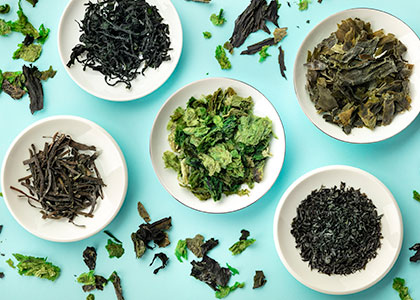
Surprising Superfoods from the Sea
By Suzanne Boothby
If you’ve recently switched to a plant-based diet, there’s a whole realm of veggies you might have missed from under the sea. While many people know nori, used to wrap sushi rolls, there’s a whole variety of edible sea vegetables that are nutrient-dense, full of minerals and even a great source of plant-based protein.
In addition, sea vegetable cultivation is sustainable and could help save the planet.
These veggies also offer a deep, savory flavor, known in the culinary world as umami. Adding them to your diet can help satisfy cravings for more indulgent foods, like parmesan cheese or burgers. Dulse, a red seaweed that grows along the Pacific and Atlantic coasts, is as nutritious as kale and many people say it tastes like bacon.
The Health Benefits
Sea veggies are considered by many health advocates to be the new kale, thanks to their high nutrient content. Sea vegetables have been a staple throughout Asia and many cultures situated near water for centuries. They have many powerful health benefits including helping to reduce abdominal fat. Their nutrition profile is off the charts boasting high amounts of dietary fiber, antioxidants, vitamins A, B, and E and minerals such as calcium, potassium, zinc, iodine, iron and more.
A-Z Sea Veggies
Here are a few of the most-known varieties and what they are known for.
Arame
Thin with wiry black ribbons, this rich black seaweed has a milder aroma and taste than other types of edible sea veggies making it a popular addition to salads (and a great “starter” sea veggie for beginners).
Dulse
Dulse looks like the outer skin of a red onion. With a reddish-brown almost purple color, it’s easy to distinguish from traditional greener seaweeds. You can find dulse dehydrated and can be eaten plain like jerky or as flakes to help season everything from salads to scrambled eggs. It has a chewy texture with a salty finish.
Nori
The classic. You’ve probably eaten these dark green sheets rolled up in sushi. Nori is packed full of iodine and vitamin C, so don’t be afraid to use it as a condiment for other dishes as well.
Kombu
Often found in thick sheets or strips, kombu has a green and sometimes purple-ish hue. Most commonly used to make the broth for miso soup, kombu can also be used in vegetable stews and to soften beans
Kelp
These large seaweeds are grey or dark brown and grow naturally in underwater forests. In supermarkets you’ll find it dried usually in sheets. You can add dried kelp to soups and also use raw kelp noodles to in entrees and salads.
Wakame
This popular sea veggie has a light green color. When soaked in water, wakame expands into large, silky sheets. It has a subtly sweet flavor and is the most tender of all the seaweeds. Often spotted floating next to tofu in miso soup, wakame is also used in seaweed salads, a popular side dish at sushi restaurants. Feel free to eat it raw too!
Spirulina
This ancient blue-green algae is most commonly found as a supplement and is a great addition to smoothies and juices. While you can find it in its natural form, most often it is consumed in tablet, flake, or powder form. Read more about the health benefits of spirulina.
Chlorella
Similar to spirulina, chlorella is a deep green algae popularly used in powder form and in capsules as a supplement. This nutrient-dense algae is full of protein, vitamin A, zinc and iron.
Where to Buy
Sea veggies are usually found dried in the international food aisle at the grocery store, at health food stores or at an Asian specialty market. Some varieties like kelp noodles or wakame may be found in the cold section of the store, near prepared foods. You can easily rehydrate sea vegetables with water or broth, or add to soups and stews.
How to Enjoy Them
You can easily add seaweed to salads, soups, dressings, stir-fries and more.
Here’s a few simple ways to try them today:
- Wrap rice and vegetables in nori to make veggie sushi wraps.
- Snack on toasted nori strips.
- Buy a shaker of sea veggies and add to anything.
- Use strips of kombu to cook beans to add flavor and make them more digestible.
- Sprinkle dulse flakes like salt on avocado toast or salad.
- Make a seaweed salad using wakame.
- Add rehydrated arame to a veggie stir-fry.
- Use kelp noodles instead of pasta made from wheat.
- Add spirulina or chlorella powder to smoothies.